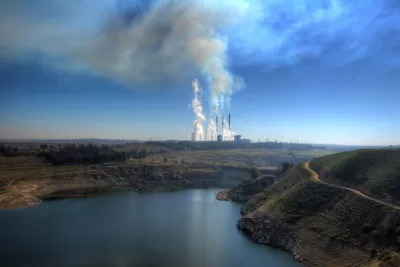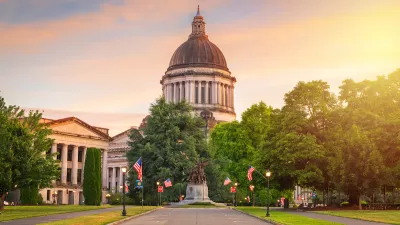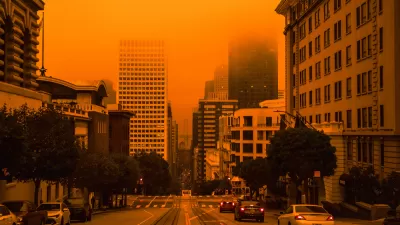On November 8, voters in the nation’s northwest corner will decide on I-732, which would create a carbon tax swap and potentially become a new model for fighting climate change.

The United Nations has called climate change the defining issue of our time and yet it is notoriously difficult to address partly due to the practical challenge of getting global industries and nations to agree on anything. While the majority of our country's attention is focused on the presidential race in the 2016 election cycle, a bold new idea for fighting climate change has quietly emerged in Washington State. On Tuesday Washingtonians will vote on I-732, an initiative that would shift taxes away from the general population and toward entities that generate carbon emissions.
I am a Seattle native and I love all corners the Evergreen State, from the rolling plains, over the mountains, and to the ocean. While the Seattle metropolitan region gets most of attention, the area only makes up a third of Washington's population. Seattle's four-county metropolitan region has an enormous influence, but for any statewide initiative to be successful, it must also work for the 35 other counties that are vastly different in terms of geography, economy, culture and political affiliation.
This is what makes the I-732 battle so interesting, and why it might actually win.
The proposal is strikingly simple and refreshingly bipartisan. According to Yes on I-732.org, I-732 would:
- Directly address climate change by adding a tax of $25/ton on carbon emissions;
- Reduce the statewide sales tax by 1%;
- Add a tax credit of $1500/year for low-income households; and
- Lower the Business and Occupation (B&O) tax on manufacturers to .001%.
This type of fossil fuel tax would be first of its kind in the United States, though it has been implemented elsewhere. According to the World Bank, 15 countries currently tax carbon. Sweden's policy is the most aggressive, at rate of $168/ton. Closer to home, a carbon tax has been in place in British Columbia, Canada, since 2008, which has resulted in a 5-15% reduction in greenhouse gas (GHG) emissions. BC's tax is much lower than Sweden's, at a rate of $30/ton.
Under I-732, carbon emissions in Washington State would be taxed at a rate of $25/ton. According to a 2013 study from Regional Economic Models, Inc, this rate would incentivize reductions in carbon emissions to 75% of 1990 levels by 2035. Washington's official GHG reduction targets are written into state law, with the goal of reducing GHG emissions to 1990 levels by 2020, and 50% below 1990 levels by 2050. Though the I-732 model does not meet the state's official target, backers of the initiative—a non-partisan grassroots group of scientists, economists, former elected officials, business owners and concerned citizens calling themselves Carbon Washington—say it is the best path forward.
I-732 is politically-savvy. On the one hand, it is unapologetically progressive. The tax swap concept presupposes that climate change exists, its sources are known, and should be taxed. On the other hand, it is also pro-business, via the proposed reduction in the Business & Occupation Tax. The B&O tax is a tax on gross receipts for Washington businesses, and some feel that it hampers the state's economic competitiveness (Washington does not have an income tax). Finally, I-732 is populist. It supports low-income households, and appeals to consumers by lowering sales taxes on everyday goods.
Given I-732's broad appeal— left, right, and center—one might expect (or hope) that the proposal would a unite interests and perspectives. Instead it has set off a fierce debate, dividing even the most die-hard climate activists and progressives.
I-732 has become a curious story, less about political ideology and more about math. The battle has been covered in the following national publications:
- Grist: "The Most Dramatic Climate Fight of the Election is in Washington State";
- Vox: "The Left vs a Carbon Tax"
- The Los Angeles Times: "How a Tax on Carbon Has Divided Northwest Climate Activists"
- CNN: "There's a Cheap, Proven Fix to the World's Biggest Problem"
- Slate: "Environmentalists’ Disdain for Washington’s Carbon Tax"
- The Wall Street Journal: "A Growth-Friendly Climate Change Proposal"
Supporters and opponents have not aligned into predictable groupings. I-732 is supported by the Audubon Washington, the Seattle Weekly, Seattle Transit Blog, and several high-profile celebrities. But it is opposed by the Fuse Washington, The Washington State Democratic Party, the Seattle Times editorial board, and The Stranger, a proudly ultra-liberal independent weekly based in Seattle. The Sightline Institute, a nonpartisan Washington State-based environmental policy think tank has written several critiques on both sides of the issue.
Those directly affected by the tax like the energy industry are not spending large sums of advertising money to defeat I-732 even though they might be opposed to the proposal. Ironically, the battle is being fought hardest from the left. When asked to explain how this could be, Greg Rock, Sustainable Energy Engineer and Executive Committee member for Carbon Washington replied, "We’re on a shoestring budget. Our biggest challenge is educating voters on what this initiative would do. People see the word 'tax' and instinctively want to vote no. That, and frankly I think the idea of supporting a centrist proposal is creating internal anguish for progressive-leaning groups. Perfect has become the enemy of good."
The difficult decision for the discerning voter is deciding which version of the enormously complex economics to believe.
If successful, I-732 could become a model for other states, especially the larger pollution generators. In 2014, Washington State was 27th on the list of states contributing the highest amounts of CO2 emissions annually.
While I-732 is unique, it is not the first attempt to address climate change.
Cap and trade is a more familiar model for reducing greenhouse gas emissions. Under this model government sets an overall limit on emissions and issues tradable permits to regulated sources. Those in the best position to reduce emissions inexpensively can over-comply and sell excess allowances to sources with higher abatement costs, enabling these sources to avoid investing in high-cost compliance measures and bringing down the overall cost of emission reduction.
In 2006, California passed the California Global Warming Solutions Act, a cap and trade program which aims to lower greenhouse gas emissions to 80% below 1990 levels by 2050. In 2015, the Obama administration approved the Environmental Protection Agency's Clean Power Plan, a revised cap and trade program that sets more ambitious benchmarks for pollution reduction by the year 2030.
Washington, along with 12 other states, does have a cap and trade program, updated earlier this year, which sets a limit on carbon emissions. But unlike I-732, the legislation does not charge emitters a fee for carbon emissions. I-732 would do this, but remains revenue-neutral due to offsetting reductions in sales taxes and B&O taxes. Supporters of I-732 say their plan is simpler than cap and trade, more aggressive, quicker to implement, and accounts for flaws in the arithmetic that goes in to figuring out how cap and trade carbon credits are priced in light of the carbon storage capabilities of forest products.
Apart from these potential benefits, the timing may be right for considering an alternative to cap and trade. In 2010, The New York Times reported that cap and trade is losing its standing as the energy policy of choice. Could a revenue-neutral tax swap like I-732 takes its place?
Climate activists will be watching the Washington State race closely. But given the focus of our current election cycle, the outcome of I-732 will probably not make headlines. Roll on Columbia, roll on.

Planetizen Federal Action Tracker
A weekly monitor of how Trump’s orders and actions are impacting planners and planning in America.

Congressman Proposes Bill to Rename DC Metro “Trump Train”
The Make Autorail Great Again Act would withhold federal funding to the system until the Washington Metropolitan Area Transit Authority (WMATA), rebrands as the Washington Metropolitan Authority for Greater Access (WMAGA).

DARTSpace Platform Streamlines Dallas TOD Application Process
The Dallas transit agency hopes a shorter permitting timeline will boost transit-oriented development around rail stations.

New Alaska Bitcoin Mine Would Burn as Much Energy as the State’s Largest Coal Plant
Fueled by “stranded” natural gas, the startup hopes to become the largest in the US, and to make Alaska an industry center.

New Jersey Duplexes Elicit Mixed Reactions
Modern, two-unit residences are proliferating in northern New Jersey communities, signaling for some a boon to the housing supply and to others a loss of historic architecture.

Renters Now Outnumber Homeowners in Over 200 US Suburbs
High housing costs in city centers and the new-found flexibility offered by remote work are pushing more renters to suburban areas.
Urban Design for Planners 1: Software Tools
This six-course series explores essential urban design concepts using open source software and equips planners with the tools they need to participate fully in the urban design process.
Planning for Universal Design
Learn the tools for implementing Universal Design in planning regulations.
Municipality of Princeton
Roanoke Valley-Alleghany Regional Commission
City of Mt Shasta
City of Camden Redevelopment Agency
City of Astoria
Transportation Research & Education Center (TREC) at Portland State University
US High Speed Rail Association
City of Camden Redevelopment Agency
Municipality of Princeton (NJ)





























